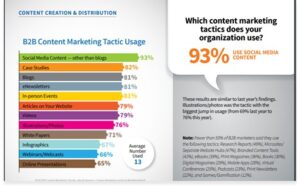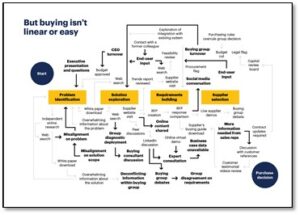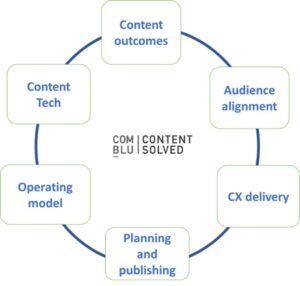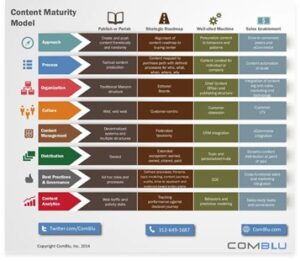“Content as a business strategy” has been lagging year after year, according to the Content Marketing Institute, a go-to source of content benchmarking data. After examining the latest CMI report, it’s clear that companies are behind the eight ball when it comes to content strategy. In the analysis, it shows that after successfully pivoting during the pandemic content teams remain in “triage mode”.
What is causing this? Their charters haven’t evolved, or they still lack one. Traditional 0perating models aren’t sustainable and technology is either unconnected and underutilized (or both). They have difficulty communicating internally and they struggle to measure.
Despite the pandemic elevating content in the marketing hierarchy, its strategic importance only rose from 72% in 2020 to 81% in 2021, a lower increase than expected given the current digital evaluation and buying environment. Notably, the percentage of survey respondents with a documented content strategy is alarmingly low at 53%, down from 59% the year before.
Content matters more than ever but the implication of this year’s study is that the content function has not advanced as much as we might expect by now. And as a result, delivering on customer experience objectives – which sits atop of the corporate priority list – is at great risk.
In the beginning
Arguably, the concept of content strategy started to pick up steam at the turn of the century. In 2000, the phrase barely registered on Google Search data at 880 results. In 2002, Ann Rockley published her ground-breaking book, Managing Enterprise Content: A Unified Content Strategy. In 2007, the Content Marketing Institute was founded by Joe Pulizzi, a leading content evangelist. By 2011, Confab, a conference devoted to content strategy debuted. And in 2012, ComBlu published the original Content Supply Chain.
With content continuing to emerge as a formalized marketing discipline, we mapped a pathway for CMOs with tools and guides such as this maturity model to systematically build strategic content functions capable of producing measurable impact.
Today, Google inquiries on content strategy clock somewhere around 886 million. So why haven’t companies’ content strategies matured over time? One notable reason: content leaders we have talked to over the last several years tell us they’ve been hamstrung. They report spending much of their time in ‘education mode,’ constantly explaining what content is, why it matters and how it should (in theory) impact the bottom line. The irony is – they have less and less time to be strategic when it’s most needed.
If we examine the top pain points and hurdles for content teams in 2021, we can see a direct correlation to a lack of strategy:
- Communication siloes
- A lack of processes
- Production workflow difficulties
- User experience (UX)
- Measurement
This list reaffirms that content still has a content problem. Meaning, these pain points largely reflect a lack of foundational – but addressable – blocking and tackling. And until that is addressed, marketing cannot fully leverage content as a strategic asset to solve business problems.
To gain some additional perspective on the state of content strategy, we took a retrospective look at some historical CMI survey responses and reviewed the studies from 2015, 2016 and 2019 along with other industry perspectives. Our goal was to glean insights for logical next steps, specifically how organizations can up-level their content strategy and operations based on their current state.
The past is prologue
It was September 2015. My colleague Cheryl and I attended the Content Marketing World conference with 3,500 of our fellow content practitioners. We were told upfront that content marketing was heading into the “trough of disillusionment” on the hype cycle, that most content was subpar, culture was working against us, and that we didn’t have enough awareness (top of the funnel) content for buyers to help them articulate their problems and evaluate solutions easily. (See 5 Takeaways from Content Marketing World 2015 for a recap.)

Photo credit: @Greencognito
The choir didn’t disagree. Content was overly ‘product and brand-centric’ then. It felt like deja-vu delivering these same diagnostics to different clients. Several had over-produced content for middle of the funnel and post-purchase engagement, so naturally most of their B2B content centered on products and how to buy and use them. This “over-indexing” left gaps in the earlier stages of the journey. Many clients were subsequently light in “awareness and consideration” asset types.
Two steps forward one step back
A year later, the 2016 CMI study data characterized the state of content marketing as tactical, experimental and considered “ineffective” by the teams themselves. Like the survey responses indicated, our clients were indeed hungry for benchmarking data; buyer consumption and preferences topped the list. Personas had to go much deeper to inform a variety of stakeholders and BUs – sales, digital, partner, developer, etc.
Back then, teams were hyper-focused on creating formats and asset types that were optimized for social media and digital channels. As a result, measurement was typically focused on asset performance and channel metrics. Neither of which told a complete ROI story. Meanwhile in-person engagement was considered the most effective tactic deployed.
If you compare the top tactics of 2016 versus asset types in use today, you can find direct correlations to our current strategy challenges that we mentioned regarding communications, workflows, processes, unconnected technology and measurement.

Source: 2016 Benchmarks, Budgets, and Trends, CMI
We see natural shifts in what types of content was developed then versus now. Assets that ranked low are now high and, in some cases, vice versa. While social media communications, case studies and blogs were top tactics in use in 2016, we now see podcasts, webinars, video and email deemed critical today.
The problem is that the content function itself has not kept up with these shifts. These newer multi-media assets and channels all add layers of operational and production complexity. Some of them can be very expensive and difficult to produce, which makes them hard to justify. Others require integrated technology, data and teams – none of which have been adequately addressed. If content charters do not evolve, these pain points will persist.
Let’s also look at the importance placed on social media. Back then, “multichannel marketing” was the vernacular and paid social was the hot ticket. Just as we were counseling our clients about balance, many companies were abandoning organic engagement in favor of the mass targeting and mass distribution that paid social offered. With that, some content became superficial, and the quality and depth suffered as a result.

A “should fit most sizes” approach does not work with B2B Buying Groups and decision-making complexity. As many in Sales will tell you, most content being produced would not work for face-to-face engagement – where “the rubber meets the road” – with prospective buyers. This is a big problem that still manifests today – a notable divide between sales and marketing teams exists over what content is produced and what is used. According to the American Marketing Association (AMA), 90% of marketing’s content goes unused by sales.
And as for the role of social media in B2B marketing today, LinkedIn has become the most important platform, given its professional networking, community building, content distribution features and reach for both sales and marketers. In addition, we see a return to community-based engagement and post-purchase support as well. All of which should help unify customer engagement efforts along the funnel.
A look back to 2019
After living through the dearth of awareness content, the pendulum swung back. This was reflected in the 2019 CMI study – 41% of the content created was for the awareness stage, an overcorrection that has effectively clogged the top of the funnel to this day. Gartner famously illustrates the difficulties buyers have due to an overwhelming amount of content and information on the problems and potential solutions already overwhelming them.

Source: New B2B Buying Journey & its Implication for Sales, Gartner
Referring to the 2016 CMI chart, the number two tactic deployed was case studies. By 2019, this asset class had exploded along with industry growth for this niche service. There were and still are content marketing agencies whose primary function is case study development. And they did just that – prolifically.
Here’s a real example. The ComBlu team conducted a content audit for a client in 2019 and discovered over 300 case studies published on their website. No product or solution should need that many case studies to tell their value story – and no surprise – the sheer volume was negatively impacting the CX. In trying to keep the content machine running and responsive, our client didn’t realize they had accumulated nearly that many. We helped the client address this through a repurposing process and identified multiple ways to leverage their valuable voice of the customer while greatly reducing the volume of the asset class. It’s also worth noting that, at the time, they were also heavy on awareness content with little in the way of product content and even less on how to buy or use it. Times were changing.
And now
So what does all this mean for struggling marketers today? To help simplify next steps, we have organized our recommendations into four core areas that should see some improvement if you get started addressing them.
1. A balanced journey. This has always been our mantra. As the pendulum swings, so do the days of our lives. We have witnessed organizations collectively over-indexing in top of the funnel content and now have excess awareness assets and several gaps to fill in other stages of the buyers’ journey. According to a Forrester content study in 2018, 77% of B2B organizations reported to having a “content waste problem.”
Action: Repurpose current content to fill those gaps, balancing the available content across the journey. This should become a repeatable and scalable process that is part of governance.
2. Volume-to-value balance. It seems as if organizations have become automated content marketing factories – cranking out and over-gating assets across all channels – with seemingly little holding it all together. The focus has been largely on lead generation and capture, with email taking over as the lead tactic. And as most can probably agree, email marketing is past the point of no return when it comes to being an overused channel. Ready? Fire. Fire again. Continue firing. Still firing. Aim.
Pressures for more personalization only exacerbate the issue. In B2B, the buying groups continue to grow; they include new roles, multiple generations and different channel preferences. If we know one thing, it’s that content must be of high quality and relevant to many buyers’ needs. And we know that the buyer-vendor gap runs deep.
Action: Keep refreshing your view into the buying center, emerging roles, industry dynamics and generational preferences. Personas should be living artifacts. Messaging should reflect those shifts.
3. Evolve operations. Compounding the problem of the sheer volume of content was that, more often than not, it wasn’t produced, distributed or measured as part of a coordinated effort. In fairness, it couldn’t have been. Every year respondents pointed to a lack of leadership and processes as key bottlenecks. Since you can’t have one without the other, small stretched-to-the-max teams became very reactive and campaign-oriented.
This project-driven operating model was not sustainable and has started to shift to a channel focus. The next chart is from the 2021 survey. While this is a more rational trend, teams need an operating model that delivers against multi-faceted and complex needs. This includes projects, channel support and providing standards and practices across organizations.

Source: 2021 Content Management and Strategy Survey, CMI
Action: Have an objective, third party map out your content landscape to inform an operating model that makes sense for your organization.
4. Need a measurement mindset. Proving broad impact on content has been virtually impossible through the years. Today, teams still struggle to extract insights from data. It maybe that they are looking at asset and channel performance only. Or they are holding out for a magic tool/silver bullet that is going to demonstrate ROI. While there are a plethora of tools and technologies to help, systems must be connected and there must be data governance in place. According to the 2021 report, Content Tech is installed, but it’s not integrated or optimized. Nor are users trained. But this is just the tip of the content technology iceberg, so we’ll have to tackle this big, hairy topic in a future post. Stay tuned.
The point: technology – even when connected – is not the whole story. Defining success and understanding what that means can only happen with a strategy and a maturity plan in place. This includes the right operating model and talent, systematic planning and publishing aides and guides, and a consistently customer-centric culture. Remembering that none of this can happen without the backing and influence of leadership.
Action: Rethink and redesign your measurement approach from the ground up; requires business strategy alignment, leadership support, internal communications and shared KPIs across teams.
Next Steps
With that backdrop, the first step is to put in place a content strategy framework if you don’t have one. Revisit and evolve the framework if you do. Be sure to actively socialize it across teams, because that is critical to helping:
- Align content programs with business objectives and teams;
- Promote consistent standards and governance, providing clarity and establishing consistency across the brand;
- Facilitate cross-team communication and collaboration;
- Provide a clear path to meaningful measurement; and,
- Help organizations actualize what it means to be customer-centric.

Source: Content Strategy Framework, ComBlu
To learn more about creating a content framework tailored to your content maturity level, evolve your current strategy, or help get your organization caught up, email us at jtlreleaven@simplfimarketing.com/comblu. We’ll walk you through a fifteen-minute presentation on the key elements of a content strategy and then drill down where you need the most help. We look forward to connecting.

Senior Consultant
Jenny is a digital content strategist, who leads customer-centric engagements that focus on understanding B2B buying behaviors and developing custom roadmaps.
Her expertise is creating buyer personas and mapping digital content journeys to assess the multi-channel user experience. She helps clients operationalize plans across workstreams and identifies processes to create efficiencies in marketing operations. Jenny also has extensive time under her belt developing and managing customer advocacy programs and community building.
She has helped a diverse group of organizations including Cisco, VMware, Verizon, Microsoft, Dell, BMO Harris, Capital One and many others become more customer-centric.


